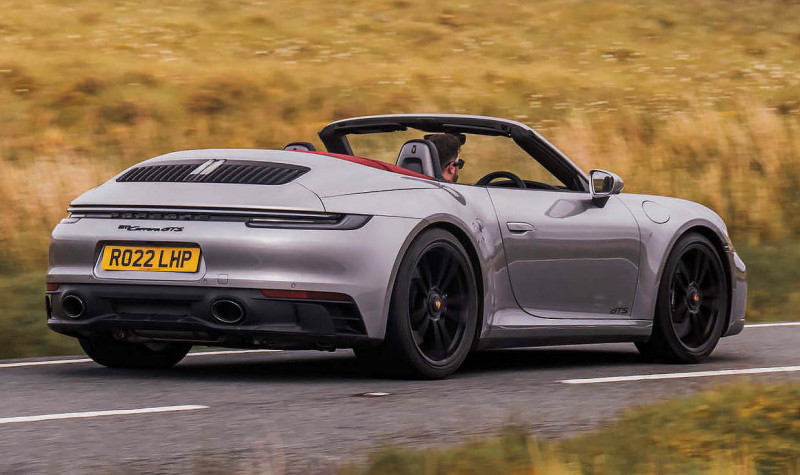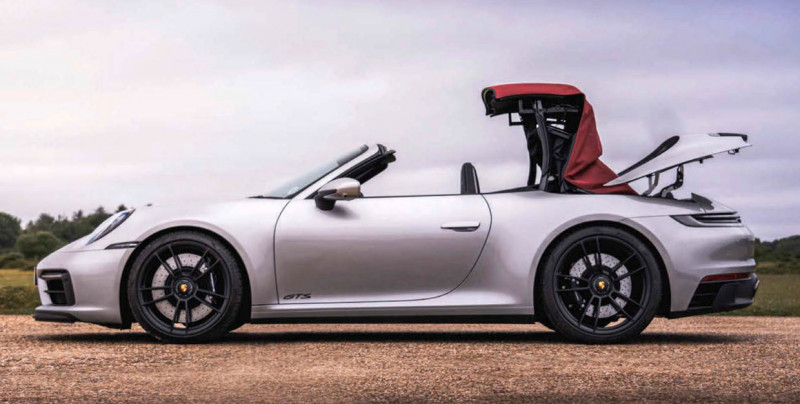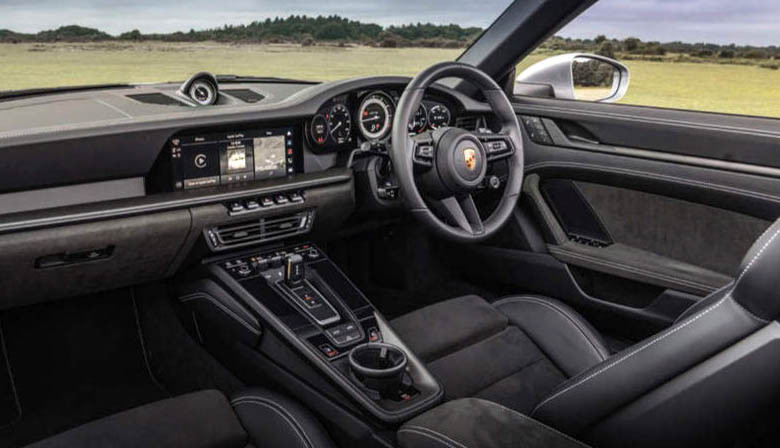2024 Porsche 911 Carrera GTS Cabriolet 992
With a wide range of models and trim options in the 992 Carrera stable, where does the GTS Cabriolet fit in? Is it a model even needed in today’s 911 showroom line-up? We get behind the wheel and find out...
Words James Fossdyke
Photography Stuart Price
STIFF COMPETITION
We test the 992 Carrera GTS Cabriolet.

As readers of our April issue will know, chiefly as a result of the magazine’s cover story announcing the 991 Carrera GTS as a future 911 icon, there was a time when the Carrera GTS offered Porsche customers the perfect sports car. Built as a halfway house between the hardcore GT3 and the more touring-oriented Carrera S and Turbo models, the GTS made the most of the 911’s dynamic potential, while providing everyday usability. The 992-generation GTS coupes, however, have failed to convince, with overly stiff suspension making them almost unacceptably uncomfortable on anything other than a perfectly smooth surface. They’re wonderful on track, but as roadrunners, they’re less than ideal.

This leaves the 992 GTS Cabriolet (particularly this rear-drive, PDK-equipped version) in something of an odd position. Old-school Porsche lore suggests an al fresco 911 ought to be compromised by its body style, which is hardly the first choice of circuit dwellers, but with driving dynamics much closer to the equivalent coupe than its predecessors could ever claim, is this mongrel a better proposition for the road than the tin-top with which it shares so much? It’s time to find out.
At first glance — quite literally — it’s a bit of a mixed bag. 992 Cabriolets have always looked slightly awkward, not least due to the model’s over-sized rear end being accentuated by large plastic grilles. Of course, this is largely down to the (non-negotiable) positioning of the engine, and it would be overly harsh to describe the car as ugly, but it’s far from the best-looking model in the 911 range. By contrast, the 992 Targa manages to integrate a convertible roof much more neatly. Happily, the GTS claws back styling points with a host of motorsport-inspired, model-specific upgrades fitted as standard. Chief among these is a ten-millimetre reduction in ride height and the inclusion of the more aggressive Sport Design bumpers, complete with the standard sports exhaust. Other noticeable upgrades include a black front spoiler, black alloy wheels and black GTS badge lettering, as well as tinted lights and black chrome tailpipe finishers. Buyers can swap standard black trim for gloss black, but expect to be asked for more than two thousand pounds for the privilege.

FIGHTING TRIM
Porsche has also made changes in the cabin, where the main upgrade seems to be extensive use of Race-Tex upholstery. You can have full leather if you want, but a stock-specification GTS Cabriolet comes with suede-like Race-Tex covering the lower dashboard, door card handles and seat centres. Additionally, there’s a GT sports steering wheel and contrasting stitching in either Carmine Red or Crayon, depending on your preference. The Sport Chrono package is included as standard, which means you get a driving mode selector on the steering and a central clock (including lap timer functionality) with an outer ring finished in the same colour as the stitching. The rev counter is also colour-coded, as are the seat belts. Carbon trim decorates the centre console and middle dash.
Naturally, the GTS Cabriolet’s standard equipment is just the starting point — Porsche will sell you countless optional extras designed to help personalise your new 911, whilst successfully relieving you of more cash. More comfort?

How about less comfort?! Choose the light-weighting package, for example, and you can have a rear seat delete, while the front pews are swapped with carbonbacked buckets. This arrangement saves twenty-five kilograms, which is about the weight of a medium-sized dog. Frankly, I’d rather leave the pooch at home. Other cost options make much more sense. The standard four-way electrically adjustable seats are best swapped for more upmarket versions, complete with seemingly infinite configuration and far more support. We’d also opt for the front-axle lift system, which makes traversing sleeping policemen just that little bit less fraught. Adaptive cruise control is likely high on the wish lists of Porsche showroom visitors, but this feature commands a price tag of more than £1,200, which we think a tad steep.
Speaking of spend, there’s a premium to pay for the GTS Cabriolet. Where the ‘basic’ GTS coupe comes in at £114,800, the price of acquiring the convertible commands an extra ten grand. This makes it £12,000 more expensive than a Carrera S Cabriolet. That’s quite a jump when you consider there’s just thirty horsepower between the two models. Plus, three of the main upgrades — namely the lower suspension, the sports exhaust and the Sport Chrono package — can be added to a 992 Carrera S for less than £4,000.
SHIFT KEY
These features aside, the GTS doesn’t offer much in the way of extra kit for your money, but this being a Porsche means buyers are given plenty of opportunity to peruse the manufacturer’s individual equipment list and shell out more than they’d perhaps anticipated. Thankfully, the gearbox isn’t something you’ll need to pay extra for. As with almost every other iteration of Carrera GTS, the Cabriolet comes with a choice of two transmissions: the PDK twin-clutch semi-automatic unit is fitted as standard, while the seven-speed manual is a no-cost option. Purists will tell you the manual cog swapper is the one to go for, especially considering Carrera GTS models get a stubbier lever for snappier shifts, but both transmissions are brilliant in their own way.
Our test car came with PDK, which is one of the best transmissions of its type, somehow always finding the right gear at the right time in a way automatic gearboxes from rival manufacturers simply can’t match. And, for drivers wanting to exercise more control over their GTS, cold-metal shift paddles are conveniently located behind the steering wheel. They feel great to the touch and elicit lightning-fast shifts up and down the eight-speed gearbox, usually accompanied by a fantastic crackle from the exhaust system.
Most of the time, though, you’ll leave PDK to its own devices, with a large amount of control coming from the Sport Chrono package. In Normal or Wet driving modes, the gearbox is less aggressive, shifting smoothly and at low engine speeds for maximum refinement and serenity, but when you move the driving mode rotary knob to Sport or Sport Plus, gears are held for longer, with ferocious snaps between ratios.
As you’d expect, the real advantage of PDK is its performance when you put your foot down. Officially, this GTS Cabriolet despatches the sprint from rest to 62mph in 3.6 seconds (just a tenth slower than the equivalent coupe), while the manual GTS Cabriolet takes 4.3 seconds to manage the same feat. In terms of top speed, however, there’s no difference, with both cars reaching an impressive 192mph.
While the gearbox has a part to play, most of the credit must go to the stonking twin-turbocharged three-litre flat-six, which is essentially the same as the engine fitted to every other 992 Carrera. Even so, where the entry-level Carrera offers 380bhp and 332lb-ft torque to play with, the GTS ups the ante to 473bhp and 420lb-ft. It’s a big difference, instantly noticeable when you push the throttle pedal deep into the carpet. Even without the aid of all-wheel drive, which allows the Carrera 4 GTS to shave another tenth from the dash to 62mph, the wide rear tyres find copious traction and hurtle the droptop GTS toward the horizon alarmingly quickly. Staggeringly, this convertible is only two tenths of a second slower to 62mph than a PDK-equipped GT3. It doesn’t hang about.
Nor does it keep quiet about its performance. Sure, if you choose the quiet exhaust setting and only gently prod the accelerator, the GTS stays sporty-but-refined without too much noise troubling the cabin, despite the reduction in soundproofing material promoted as part of the GTS package. Get a bit bolshie with the throttle and select a more aggressive driving mode, however, and all hell will break loose. The engine snarls away behind your left ear, while the exhaust barks in excitement as the needle shoots around the face of the tachometer. And when you’ve had enough of accelerating, easing off the throttle will see excess fuel sprayed into the exhaust to explode in a cacophony of crackles and pops. It’s enough to make bystanders jump in alarm.
Key to any 911, and the GTS models in particular, is the way it moves around corners. Put simply, the GTS is built to be the best-handling of the Carrera line-up. To this end, the car’s underpinnings have been inspired by the more expensive Turbo S (to be featured in next month’s issue of 911 & Porsche World). This means you get the aforementioned lowered suspension and Porsche Active Suspension Management (PASM) as standard, but there are now helper springs at the rear. The GTS also benefits from upgraded brakes, matching those of the 911 Turbo.
All of which should make the GTS pretty formidable when it comes to cornering, even in Cabriolet form. Unsurprisingly, it delivers with ease. Gone are the days when droptop Porsches felt flaccid when compared to their hard-top siblings. The GTS Cabriolet feels every bit as poised as the equivalent coupe. Therein lies a fundamental problem with GTS trim: the ride. As with the GTS coupe, the GTS Cabriolet, though softer, remains too stiff for UK road use. Those who dare venture over a potholed road — is there any way of avoiding them?! — will feel as though they’ve been thumped in the back repeatedly. Things improve as speed builds, and while it would be churlish to suggest motorway miles are wildly uncomfortable, the low-speed ride is borderline unacceptable. Admittedly, this is as much the fault of British road maintenance as it is of Porsche chassis tuning, and we’re not saying the GTS is as harsh as a GT3, but the fact remains you’ll have a much smoother ride in a Carrera S (or even a Turbo S), despite the shared suspension components.
THEM’S THE BRAKES
On the plus side, this stiffness translates to fantastic body control. Indeed, on this front, 992 GTS models are second only to the Turbo S and GT3. The steering feel is magical, and although the brake pedal feels a tad sloppy through the first few millimetres of travel, the brakes themselves are hugely powerful.
This, combined with the copious amounts of grip provided by those broad tyres, gives the GTS an uncanny ability to corner flat and true at pretty much any speed. There’s no sense the car is keen to misbehave, and when you finally provoke it into doing so, corrections are made intuitive by the perfectly judged control weights common to so many Porsche products.
Our test car came with the optional four-wheel-steering system, which only helped to increase the sense of agility and poise. At low speeds, the rear wheels turn in the opposite direction to those at the front, giving you additional manoeuvrability, while at higher speeds, the back wheels turn in the same direction as the fronts, increasing stability. It’s a very subtle system — the back wheels only turn by a few degrees — but it helps reduce the turning circle and allows the 911 to dart into corners even more rapidly.
All of which makes the 992 GTS Cabriolet the unquestionable king of the mountain road, delivering flea-like agility and bringing you closer to sunshine and the scream of the flat-six engine. This 911 still feels like a bit of a contradiction in terms, though, particularly with rear-wheel drive and the automatic gearbox.
You see, as already outlined, the ride is simply too stiff, unless you’re really into track days, in which case the GTS coupe is undoubtedly going to have more appeal than the Cabriolet. Besides, those who want an involving, driver-oriented, rear-drive convertible will probably want a manual gearbox, leaving this particular iteration of the 911 in something of an automotive no-man’s land.
For those seeking an open-top 911 feeling luxurious and relaxing (but still enjoyable to drive hard), a Carrera 4S Cabriolet with a few choice options is the way to go, while for those who want a track-day toy, a manual GTS coupe or a GT3 will be much more exciting.
Above and below Three-litre twin-turbo makes light work of propelling the GTS Cabriolet forward at rapid pace, to the extent this 911 is only two tenths of a second slower to 62mph from rest than a PDK-kitted 992 GT3.
THE UNQUESTIONABLE KING OF THE MOUNTAIN ROAD, DELIVERING FLEA-LIKE AGILITY AND BRINGING YOU CLOSER TO THE SCREAM OF THE FLAT-SIX
Above Body control is sublime, but on anything other than roads as smooth as a billiard table, the ride is unduly harsh.
Above Electric roof retraction process is a fascinating watch.
Below Interior is a fantastic mix of leather and Alcantarastyle Race-Tex fabric.
Above More than any other current 911, the Cabriolet body style demonstrates just how big the Porsche flagship has become.
TECHNICAL DATA
- Model 911 (992) Carrera GTS Cabriolet
- Price Carrera GTS Cabriolet from £124,800, car as tested £131,994
- Powertrain 3.0-litre flat-6 twin-turbocharged
- Economy 25.0mpg
- CO2 emissions 248-256g/km
- Top speed 193mph
- 0-62mph 3.6 seconds
- Max Power 473bhp @ 6500rpm
- Max Torque 420lb-ft @ 2300-5000rpm


